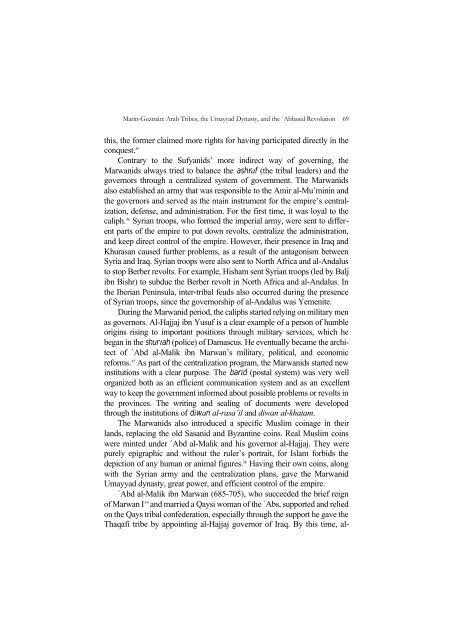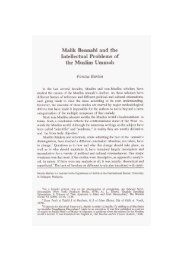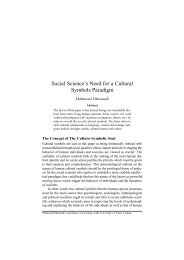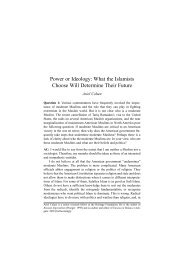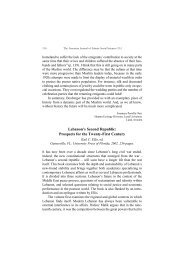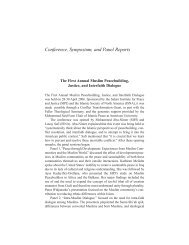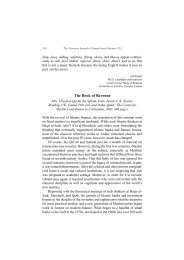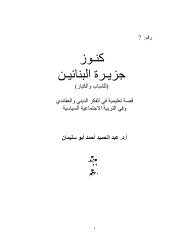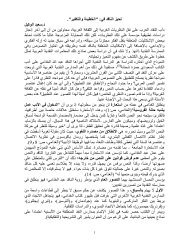Arab Tribes, the Umayyad Dynasty, and the `Abbasid ... - Epistemology
Arab Tribes, the Umayyad Dynasty, and the `Abbasid ... - Epistemology
Arab Tribes, the Umayyad Dynasty, and the `Abbasid ... - Epistemology
You also want an ePaper? Increase the reach of your titles
YUMPU automatically turns print PDFs into web optimized ePapers that Google loves.
Marín-Guzmán: <strong>Arab</strong> <strong>Tribes</strong>, <strong>the</strong> <strong>Umayyad</strong> <strong>Dynasty</strong>, <strong>and</strong> <strong>the</strong> <strong>`Abbasid</strong> Revolution 69<br />
this, <strong>the</strong> former claimed more rights for having participated directly in <strong>the</strong><br />
conquest. 55<br />
Contrary to <strong>the</strong> Sufyanids’ more indirect way of governing, <strong>the</strong><br />
Marwanids always tried to balance <strong>the</strong> ashraf (<strong>the</strong> tribal leaders) <strong>and</strong> <strong>the</strong><br />
governors through a centralized system of government. The Marwanids<br />
also established an army that was responsible to <strong>the</strong> Amir al-Mu’minin <strong>and</strong><br />
<strong>the</strong> governors <strong>and</strong> served as <strong>the</strong> main instrument for <strong>the</strong> empire’s centralization,<br />
defense, <strong>and</strong> administration. For <strong>the</strong> first time, it was loyal to <strong>the</strong><br />
caliph. 56 Syrian troops, who formed <strong>the</strong> imperial army, were sent to different<br />
parts of <strong>the</strong> empire to put down revolts, centralize <strong>the</strong> administration,<br />
<strong>and</strong> keep direct control of <strong>the</strong> empire. However, <strong>the</strong>ir presence in Iraq <strong>and</strong><br />
Khurasan caused fur<strong>the</strong>r problems, as a result of <strong>the</strong> antagonism between<br />
Syria <strong>and</strong> Iraq. Syrian troops were also sent to North Africa <strong>and</strong> al-Andalus<br />
to stop Berber revolts. For example, Hisham sent Syrian troops (led by Balj<br />
ibn Bishr) to subdue <strong>the</strong> Berber revolt in North Africa <strong>and</strong> al-Andalus. In<br />
<strong>the</strong> Iberian Peninsula, inter-tribal feuds also occurred during <strong>the</strong> presence<br />
of Syrian troops, since <strong>the</strong> governorship of al-Andalus was Yemenite.<br />
During <strong>the</strong> Marwanid period, <strong>the</strong> caliphs started relying on military men<br />
as governors. Al-Hajjaj ibn Yusuf is a clear example of a person of humble<br />
origins rising to important positions through military services, which he<br />
began in <strong>the</strong> shurtah (police) of Damascus. He eventually became <strong>the</strong> architect<br />
of `Abd al-Malik ibn Marwan’s military, political, <strong>and</strong> economic<br />
reforms. 57 As part of <strong>the</strong> centralization program, <strong>the</strong> Marwanids started new<br />
institutions with a clear purpose. The barid (postal system) was very well<br />
organized both as an efficient communication system <strong>and</strong> as an excellent<br />
way to keep <strong>the</strong> government informed about possible problems or revolts in<br />
<strong>the</strong> provinces. The writing <strong>and</strong> sealing of documents were developed<br />
through <strong>the</strong> institutions of diwan al-rasa’il <strong>and</strong> diwan al-khatam.<br />
The Marwanids also introduced a specific Muslim coinage in <strong>the</strong>ir<br />
l<strong>and</strong>s, replacing <strong>the</strong> old Sasanid <strong>and</strong> Byzantine coins. Real Muslim coins<br />
were minted under `Abd al-Malik <strong>and</strong> his governor al-Hajjaj. They were<br />
purely epigraphic <strong>and</strong> without <strong>the</strong> ruler’s portrait, for Islam forbids <strong>the</strong><br />
depiction of any human or animal figures. 58 Having <strong>the</strong>ir own coins, along<br />
with <strong>the</strong> Syrian army <strong>and</strong> <strong>the</strong> centralization plans, gave <strong>the</strong> Marwanid<br />
<strong>Umayyad</strong> dynasty, great power, <strong>and</strong> efficient control of <strong>the</strong> empire.<br />
`Abd al-Malik ibn Marwan (685-705), who succeeded <strong>the</strong> brief reign<br />
of Marwan I 59 <strong>and</strong> married a Qaysi woman of <strong>the</strong> `Abs, supported <strong>and</strong> relied<br />
on <strong>the</strong> Qays tribal confederation, especially through <strong>the</strong> support he gave <strong>the</strong><br />
Thaqafi tribe by appointing al-Hajjaj governor of Iraq. By this time, al-


